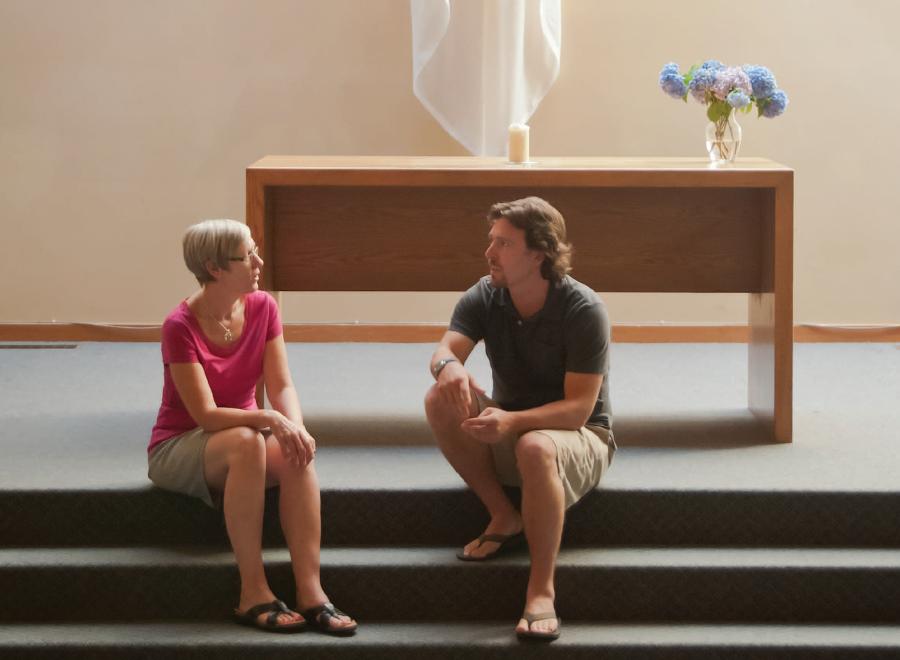Before they got to know each other, Rev. Nancy Talbot had heard all about Pastor Sean Graham. Colleagues suggested they meet. Neither one was in a big rush. Talbot has ministered at Mount Seymour United in North Vancouver since 2004. Just down the highway, Graham led the Cove Community Church, a vibrant Christian and Missionary Alliance congregation begun a decade ago as an offshoot of Vancouver’s North Shore Alliance Church. Theologically conservative, the Christian and Missionary Alliance is an evangelical denomination with over 400 churches and 130,000 members across Canada.
Talbot, who believes she and her partner, Rev. Brenda Fawkes, hold the distinction of being The United Church of Canada’s first same-sex couple to bear children while both serving congregations, describes herself as a feminist, evolutionary and progressive Christian. She’d heard Graham was “liberal,” but she recalls thinking, “How liberal is he really going to be?” Graham, at the same time, says he wondered about Talbot’s theological grounding.
Then, in September 2011, she got a call. Graham and the Cove congregation were looking for a venue for a film night on homelessness; would Mount Seymour lend a screen? Talbot said sure, and they decided to hold the event jointly. Six months later, the Cove started renting worship space from Mount Seymour.
“I laughed that night,” Talbot says. “The first film they chose [Homeless Voices, 2010] featured Rev. Ric Matthews and First United Church. The second one [The Cats of Mirikitani] had the daughter of [late B.C. Conference staffperson] Art Jones in it. They were showing films with our people in them.”
So Talbot suggested meeting Graham for coffee. “I remember I said, ‘I assumed I would want nothing to do with you.’ I mean, we have a rainbow flag on the front door. But six weeks after that first coffee, we’d become friends and trusted colleagues.”
They found a lot in common. Both were reading Phyllis Tickle; both have two children and a long-term spouse; both serve congregations that are very affluent, mostly white and activist. In fact, the issues that arise in their ministries are similar: guilt associated with extreme wealth; illness; addiction; and a younger generation with little interest in church.
Graham, to be sure, isn’t your average Christian and Missionary Alliance pastor. Gay-friendly, committed to social justice and open-minded, he’s most easily classified as part of the emerging “progressive evangelical” movement. The Cove’s tagline is “spiritual recovery and transformation.” At first glance, these folks seem within reach of the United Church’s ecumenical hug. They’re green. They’re inclusive. They’re committed to helping Canada’s most marginalized.
Yet they’re not fleeing their own faith, en masse, in favour of liberal Protestantism.
Instead, what Talbot and Graham have found is that, in the midst of the push-and-pull conversations exploring each other’s substantially different theologies, there’s a fruitful place full of humour, challenge and real growth. The two congregations have worshipped together and are planning more joint events. Talbot says the United Church has a lot to learn from the Alliance. Graham says the Alliance has a lot to learn from the United Church.
Take social justice work. Talbot points out that, at the Cove, congregants are fired up about justice and approach their work in the Downtown Eastside and elsewhere with a sense of fun, passion and mission. But in the United Church, “we’ve become quite ugly about seeking justice,” she says. “We hammer it into each other in a way that can be quite unchristian. It’s like, if you’re not doing it, you’re not a good Christian.”
Talbot also notes that the Alliance’s offshoot churches don’t have buildings to keep up — a major difference. She says United Church congregations can usually visualize amalgamation, out of necessity. But the jump to no building is unimaginable. To her, being unfettered by a building can give congregants room to grow in mission and faith.
On the other hand, Graham says the United Church’s deep tolerance for diversity challenges the Alliance’s penchant for excluding people from congregations — especially when it comes to sexuality. “If you take really seriously the words of Jesus, if [sexual orientation] were important to him, he would have talked about it.” Victimizing gay people, he continues, implies “that they are less loved or they have less to say than I do. It makes me crazy. I have so many friends who have been hurt so, so deeply because of it. I won’t be a part of it.”
Evangelicals, Graham says, are also newer to inclusive language than the United Church and can learn much from the denomination’s progress over the past 30 years. Plus, he adds, the respect for the past is refreshing. In his tradition, new is good, and anything old is to be disregarded.
What’s the most odious thing the other believes?
Talbot relishes the question. “You believe in the bodily resurrection. I’m curious how you can believe it. I just haven’t heard it,” she tells Graham.
“That’s the one I’m most curious about, too,” he counters.
“I don’t need a body to believe. That’s shallow,” she says. They both start to laugh.
Graham notes that Christians are always talking about “exclusionary excuses” for disregarding others’ theology. “Yet all through the text, Jesus commands us to love one another.”
Talbot elaborates: “We hold the place of curiosity about each other. We still have lots to discover. We may have some thoughtful differences, but I really believe our core values are in line. We both have the desire to be something other than what we have been.”
“To become something great,” says Graham.
It would be easy to write off the significance of this unlikely friendship by arguing that it’s only possible because Graham himself is more United Church-y than most evangelicals. But that doesn’t give adequate credit to the bridging happening here. As much as Graham is a revolutionary, he hasn’t left the Alliance Church. Nor has he been kicked out (yet).
The story of Talbot and Graham’s friendship would also be shortchanged without mentioning the broader church context and whether a more formal relationship between the two denominations is possible, or even desirable.
The Christian and Missionary Alliance is notably absent from the progressive-leaning World Council of Churches. It’s also the faith home of Conservative Prime Minister Stephen Harper. As investigative journalist Andrew Nikiforuk recently argued, Harper’s religion may be motivating Canada’s most controversial policies.
“From where does the government’s extreme animus towards journalists, environmental groups, First Nations and science . . . arise?” wrote Nikiforuk in the Tyee, an online B.C. magazine. “The moment demands we take a close look at Stephen Harper’s evangelical beliefs.” Nikiforuk goes on to link Alliance doctrine with extreme libertarianism, free-market ideology and climate change denial.
The Alliance Church also opposes same-sex marriage, and the manual allows for “discipline” of congregation members who engage in homosexuality. In early July, the church’s biannual General Assembly voted to extend ordination to women. The United Church did the same in 1936.
For your average social-gospel-rooted United Church member, partnering with this group might test the limits of ecumenism. But humility, of course, is called for. Growing up in the Alliance church, Graham believed that United Church members were “spiritually dead,” a “watered-down people who thought they were Christians but are not.” He didn’t want to associate with liberal Protestants, out of fear of catching a “spiritual disease.”
“Yes, there’s quite a lot of discrimination on our side of the street, but it’s mutual,” he says. “We both look across with suspicion.”
Institutionally, a relationship between the Alliance and United churches is probably a ways off. But if Talbot and Graham’s evolving friendship is an indication, forging individual relationships offers something new.
In fact, Graham’s management of his theologically diverse congregation provides a hopeful model. The Cove, unlike some other Alliance congregations, does not exclude people. Instead, Graham preaches about love.
As someone who’s come from a theology of exclusion, then transformed, he sees radical inclusion across ideologies and assumptions as his mission. “We’re trying to create a community,” Graham says. “You can be as conservative or as liberal as you want [at the Cove], but you have to be prepared to love the other. We are truly inclusive. We can strongly disagree and love each other deeply. Love and agreement are not correlated.”
In towns and cities across Canada, United Church congregations have Alliance neighbours. While agreement between the two denominations is unlikely, maybe there’s room for a little more love.
***
This story first appeared in The United Church Observer’s October 2012 issue with the title “Common ground.”


Comments